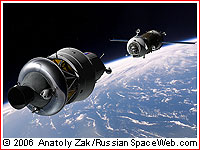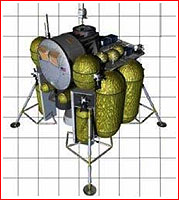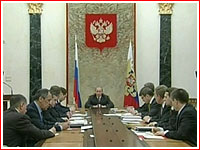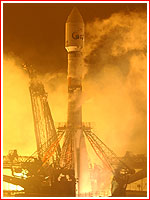Space exploration in 2006 (original) (raw)
Russian space program in 2006
During 2006, Russian economy, fueled by high oil prices, continued maneuvering out of the post-Soviet crisis with the 6.9-percent growth. Resulting increase in the federal budget finally started trickling down into the chronically underfunded space industry and prompted Russian officials to make fresh declarations about long-term plans in space. In the meantime, Russian military spending approached 600 billion rubles, or double of its annual budget in 2000. (240)
In December 2006, Russian President Vladimir Putin visited a strategic missile base in Teikovo and Cosmodrome Plesetsk. In the wake of this "inspection trip," Putin held a meeting of his cabinet in Kremlin on December 14, 2006, discussing today and tommorrow of the nation's rocket and space program. Putin announced that draft of a government decree envisoned the conslidation of various space projects into a single program, which would look 30-40 years ahead.
Also, during the Kremlin meeting Putin directed Prime Minister Fradkov to take personal responsbility for modernization of the residential infrascture in Plesetsk, which the president characterized as totally obsolete. Putin also asked Minister of Defense Sergei Ivanov to accelerate deployment of the GLONASS satellite navigation network and make the system available to civilian users.
PILOTED SPACE PROGRAM
Russia charts its future in space
Published: 2006 Aug. 29
Russia plans to abandon the International Space Station sometime between 2015 and 2025, replacing it with a domestically developed outpost in the Earth orbit, a top space official said.
Speaking on Tuesday, August 29, 2006, at the 5th International Aerospace Congress in Moscow, Deputy Chief of the Federal Space Agency, Vitaly Davydov said that the new station would be inserted into a high-inclination orbit, which would enable its crew to observe most of Russia. Currently, cosmonauts onboard the ISS can only see small fraction of the Russian territory due to its orbit, which was compromised to allow the cooperation with the United States. (Launches from Cape Canaveral would not be possible into the high-inclination orbit, which Russia planned for the Mir-2 space station, before abandoning the project for the ISS in 1993.) According to Davydov, the orbit of the new station would have an inclination of 70 degrees toward the Equator, as oppose to 51 degrees of the ISS.
Along with its role as a remote-sensing platform, the future station would be used for material processing research and the development of technologies for manned missions to the Moon and Mars, Davydov said. Prior to the development of the new station, Davydov promised to complete the Russian segment of the ISS by 2011. One of the new elements of the current outpost would be an Oka-T free-flying module dedicated to the material processing research.
Davydov's announcement is not a surprise to the observers of the Russian space program. In April 2001, as political problems crippled the ISS project, Yuri Koptev, the head of the Russian Space Agency at the time, discussed the possibility of the "small" Russian station eventually succeeding the international outpost.
Beyond the station
Davydov's speech (originally meant to be delivered by the head of Federal Space Agency Anatoly Perminov) outlined a whole spectrum of nation's space activities in the next several decades. It confirmed the agency's commitment to modify the Soyuz spacecraft for the missions to the Moon and possibly later, to replace it with a new-generation spacecraft in cooperation with Europe. At the same time, Davydov said that the actual implementation of plans for manned expeditions to the Moon and Mars would not start before 2025-2030. Clearly aiming at the unilateral decision by the US to return astronauts to the Moon, Davydov said that Russia would only participate in the international effort to send humans to other planets.
Unmanned missions
Russia also plans to revive the nation's planetary exploration program with launches of the Phobos-Grunt spacecraft toward Mars and its moon Phobos, and later, the Venera-D mission to Venus and Luna-Glob toward the Moon. A fleet of three astronomy observatories of the Spektr series, along with Koronas-Foton and Intergeliozond were promised funding as well.
Russia, Europe aim for the Moon
Published: 2006 July 22
Facing exclusion from the active participation in the NASA lunar exploration program, Russia and Europe ponder a cooperative program, which would compete with the US effort to return a man to the Moon.
On July 19, 2006, Russian space agency, Roskosmos, announced that it is re-focusing its future plans from the development of the Kliper reusable transport to the low Earth-orbit, to a Soyuz-based vehicle capable of missions around the Moon. The move came only a month after European Space Agency, ESA, made a decision to embark on a two-year study in cooperation with Russia on possible development of spacecraft capable of reaching lunar orbit.
The latest Russian-European plans aim to parallel or even beat American astronauts on the Moon. The competitive nature of the program stems from the current NASA policy to exclude international partners from the development of any significant elements of the US lunar hardware.
Since 1993, the US, Europe, Russia and number of other countries have cooperated in the development of the International Space Station, ISS. The program's real and imaginary ills faced fierce criticism from nationalists on both sides of the Atlantic. In 2004, using the Columbia accident as a pretext, the right-wing government in the US announced its intention to withdraw from the ISS project and ordered NASA to devise unilateral plans to return American astronauts to the Moon.
NASA invites partners to a lunar base
Published: 2006 Dec. 4
NASA officials, leading the US effort to return humans to the Moon, said they were expecting international partners, to contribute to the construction, operation and use of a future lunar outpost.
Speaking at the formal unveiling of a proposed lunar architecture on Monday, Dec. 4, 2006, NASA Deputy Administrator Shana Dale, said that the agency had committed to the construction of a permanently occupied lunar base beginning in 2020.
Dale said that beginning in 2007, NASA would actively engage international partners into discussions on their possible contribution into the program. She specifically mentioned a proposed Russian-European lunar transportation system, which could provide needed redundancy to the US-built rockets and landers, supplying the base. The origin of this philosophy can be traced to the International Space Station program, whose survival after the loss of the Space Shuttle Columbia in 2003, was ensured by the Russian Soyuz and Progress transport ships.
Russian orbital launch attempts in 2006:
| | Launch date | Time of launch | Payload | Mission | Launch vehicle | Launch site | Launch complex | Launch pad | Launch results | | | ------------------ | ------------------------------------- | ----------- | -------------------------------------------------------------------------------------------------------------------------------------------------------------------------------------------------------------------------------------------------------------------------------------------------------------- | -------------------------------------- | ------------------------------------- | ----------------------------- | ---------------------------- | ------------------ | ------- | | 1 | 2/15/2006 | 23:35* | EchoStar X | Zenit-3SL | Pacific Ocean | Success | | | | | 2 | 2/28/2006 | 23:10 | ARABSAT-4A | Proton-M | Baikonur | 200 | 39 | Failure | | | 3 | 3/30/2006 | 06:30:20 | Soyuz TMA-8 | Soyuz FG | Baikonur | 1 | 5 | Success | | | 4 | 4/12/2006 | 23:30* | JCSAT-9 | Zenit-3SL | Pacific Ocean | Success | | | | | 5 | 4/24/2006 | 20:03:24 | Progress M-56 | Soyuz-U | Baikonur | 1 | 5 | Success | | | 6 | 4/25/2006 | 20:46 | EROS-B1 | Start-1 | Svobodny | Success | | | | | 7 | 5/26/2006 | 22:50 | Compass-2 | Shtil | - | K-84 Ekaterinburg | - | Success | | | 8 | 6/15/2006 | 12:00 | Resurs DK-1 No. 1 | Soyuz-U | Baikonur | 1 | 5 | Success | | | 9 | 6/18/2006 | 02:44:05 | Kazsat | Proton-K | Baikonur | 200 | 39 | Success | | | 10 | 6/18/2006 | 07:50 | Galaxy-16 | Zenit-3SL | Pacific Ocean | Success | | | | | 11 | 6/24/2006 | 19:08:17 | Progress M-57 | Soyuz-U | Baikonur | 1 | 5 | Success | | | 12 | 6/25/2006 | 08:00 | US-PU (Kosmos-2421) | Military | Tsyklon-2 | Baikonur | 90 | | Success | | 13 | 7/12/2006 | 19:08 | Genesis Pathfinder-1 | Dnepr | Dombarovskiy | - | - | Success | | | 14 | 7/26/2006 | 23:43:00 | Belka UniSat-4 Baumanets PiCPoT CubeSat (ION) CubeSat (SACRED) CubeSat (ICE Cube 1) CubeSat (KuteSat) CubeSat (RINCON) CubeSat (HAUSAT-1) CubeSat (nCUBE-1) CubeSat (SEEDS) CubeSat (AeroCube-1) CubeSat (CP-2) CubeSat (MEROPE) CubeSat (ICE Cube 2) CubeSat (CP-1) CubeSat (Voyager) | Dnepr | Baikonur | 109 | Failure | | | | 15 | 7/28/2006 | 11:05:29 | Kompsat-2 | Rockot | Plesetsk | 133 | 3 | Success | | | 16 | 8/5/2006 | 01:48 | HOT BIRD 8 | Proton-M | Baikonur | 200 | 39 | Success | | | 17 | 8/21/2006 | 03:27* | Koreasat 5 | Zenit-3SL | Pacific Ocean | - | - | Success | | | 18 | 9/18/2006 | 08:08:40 | Soyuz TMA-9 | Soyuz-FG | Baikonur | 1 | 5 | Success | | | 19 | 10/19/2006 | 20:28:13 | Metop | Soyuz-2.1a/Fregat | Baikonur | 31 | 6 | Success | | | 20 | 10/23/2006 | 17:40:36 | Progress M-58 | Soyuz-U | Baikonur | 1 | 5 | Success | | | 21 | 11/8/2006 | 23:01:00 | ARABSAT 4B | Proton-M | Baikonur | 200 | 39 | Success | | | 22 | 12/12/2006 | 02:28:43 | MEASAT-3 | Proton-M | Baikonur | 200 | 39 | Success | | | 23 | 12/19/2006 | 17:00:19 | SAR-Lupe-1 | Cosmos-3M | Plesetsk | 132 | 1 | Success | | | 24 | 12/24/2006 | 11:34 | Meridian No. 1 | Military | Soyuz-2.1a/Fregat | Plesetsk | 43 | 4 | Success | | 25 | 12/25/2006 | 23🔞12 | Uragan-M Uragan-M Uragan-M | Military | Proton-K | Baikonur | 81 | 24 | Success | | 26 | 12/27/2006 | 17:19:42 | COROT | Soyuz-2.1b/Fregat | Baikonur | 31 | 6 | Success | |
Russian sub-orbital launch attempts in 2006:
| Launch date | Time of launch | Vehicle | Launch site | Launch results |
|---|---|---|---|---|
| 1/21/2006 | 11:00 | A-135 (53T6) | Sary Shagan | Success |
| 4/22/2006 | Cosmos-3M | Kapustin Yar | Success | |
| 6/30/2006 | 10:25 | R-29RM Sineva | Sea | Success |
| 8/3/2006 | 13:38 | Topol | Plesetsk | Success |
| 9/7/2006 | Bulava | Sea | Failure | |
| 9/9/2006 | 15:20 | R-29RM Sineva | Sea | Success |
| 10/25/2006 | 17:05 | Bulava | White Sea | Failure |
| 11/9/2006 | 14:35 | UR-100N UTTKh | Baikonur | Success |
| 12/5/2006 | 11:00 | A-135 (53T6) | Sary Shagan | Success |
| 12/21/2006 | R-36M2 | Dombarovsky | Success | |
| 12/24/2006 | Bulava | Sea | Failure |
Cancelled missions:
Delayed from 2002: A Strela rocket launch from Svobodny. (cancelled)
Delayed from Oct. 6, 2006: The Dnepr booster to launch the Lunar Trailblazer spacecraft from Baikonur for the US-based TransOrbital commercial venture toward the Moon.
Delayed from 2005: A Cosmos-3M to launch four Disaster Monitoring Constellation, DMC, satellites.
Chronology of important events in space and rocket technology in 2006:
| Date | Category | Event |
|---|---|---|
| 1/27/2006 | US/planetary | The planned summer 2006 launch of the Dawn spacecraft intended to visit two of the solar system's largest asteroids has been indefinitely postponed. Mission managers were ordered to halt work on Dawn in the fall of 2005, while an independent review team led by the space agency's Marshall Space Flight Center assessed the project. |
| 3/27/2006 | US/SEI | NASA has authorized contract extensions for development of the agency's new Crew Exploration Vehicle. The companies, Lockheed Martin Corp., and a team of Northrop Grumman Systems Corp., and The Boeing Co., were selected as CEV Phase 1 contractors in June 2005. They have been working with NASA to define requirements and develop conceptual designs for the agency's next-generation vehicle for human space flight. The estimated maximum total value for each Phase 1 contract, including the extension to Aug. 31 and the optional extension periods, is approximately 60millionforeachcontractor.TheapproximatevalueofthebasicextensionperiodfromMarch31toAug.31is60 million for each contractor. The approximate value of the basic extension period from March 31 to Aug. 31 is 60millionforeachcontractor.TheapproximatevalueofthebasicextensionperiodfromMarch31toAug.31is17.5 million for each contractor; the approximate value of each two-month option is $7 million. One of the Phase 1 contractors will be selected as the Phase 2 prime contractor to design, develop, test, evaluate and produce the CEV. Although the new contract authorizations include options that could extend the Phase 1 work until December, NASA expects to select the Phase 2 prime contractor by August. The new contract extends Phase 1 work from March 31 until Aug. 31 and adds options for a pair of two-month extensions for each contractor. The first two-month option would extend Phase 1 work to Oct. 31, 2006. The second two-month option would extend Phase 1 work to Dec. 31. 2006. The new spacecraft is expected to carry up to six astronauts into Earth orbit soon after the space shuttle is retired in 2010 and then on to the moon by 2018. The Crew Exploration Vehicle is a key element of the Vision for Space Exploration, which returns human explorers to the moon, Mars, and beyond. |
| 2/14/2006 | RF/Manned/Moon/Mars | Rocket and Space Corporation Energia after S.P. Korolev held the meeting of the broadened Scientific-Technical Board according to the agenda “Review of the Problems Facing Russian Manned Cosmonautics Development Over the 2006-2030 Period”. The Corporation’s President, General Designer, Chairman of the Scientific-Technical Board N.N. Sevastiyanov delivered the report entitled “Concept of Manned Cosmonautics Development”. Also the meeting participants heard the following supporting papers:• “Incremental Deployment of the International Space Station Russian Segment”, the speaker – I.I. Khamits, RSC Energia’s Head of Division• “Transportation Space System Clipper”, the speaker – N.A. Brukhanov, RSC Energia’s Deputy General Designer;• “Moon Program”, the speaker – the Corporation’s President, General Designer N.N. Sevastiyanov• “Martian Program”, the speaker – RSC Energia’s chief researcher L.A. Gorshkov. The following participants took part in the debate on the report and supporting papers: RAS academicians B.Y. Chertok, O.M. Belotserkovsky, G.I. Severin, I.V. Barmin; Head of Manned Programs Office of Federal Space Agency A.B. Krasnov; General Director of GNPRKTs “TsSKB – Progress” A.N. Kirilin, as well as RSC Energia’s managers responsible for subject lines of activities – A.F. Strekalov, V.I. Verkhoturov, V.N. Branets, V.A. Solovyov, S.Yu. Romanov. The decision was taken to submit the reviewed RSC Energia’s proposals regarding the concept of Russian manned cosmonautics development to Federal Space Agency and discuss on a regular basis the issues concerned with drawing up the national program of manned cosmonautics development during subsequent meetings of the Corporation’s Scientific-Technical Board. |
| 6/3/2006 | ESA/ISS | A large orbital laboratory module, built by EADS as part of Europe's contribution to the International Space Station, has been delivered to the Kennedy Space Center in Florida. The Columbus research module - developed and produced through a ten-year initiative led by EADS SPACE Transportation - is to be launched aboard the NASA Space Shuttle in the autumn of 2007. |
| 5/18/2006 | US/SEI | NASA has chosen the RS-68 engine to power the core stage of the agency's heavy lift cargo launch vehicle intended to carry large payloads to the moon. The announcement supersedes NASA's initial decision to use a derivative of the space shuttle main engine as the core stage engine for the heavy lift launch vehicle. |
| 6/5/2006 | US/SEI | NASA announced Monday agency center responsibilities associated with the Constellation Program for robotic and human moon and Mars exploration. |
| 6/6/2006 | US/planetary | Atlas rocket to launch Mars Science Laboratory Lockheed Martin's Atlas V rocket has been selected by NASA to launch the Mars Science Laboratory (MSL) mission in 2009 from Cape Canaveral, Fla. The mission will fly on a powerful Atlas V 541 configuration to propel MSL on a half-year journey to the red planet. |
| 6/22/2006 | RF/Manned/Moon | ESA’s ruling council, which met at the agency’s headquarters in Paris, France, on June 21 and 22, 2006 made a decision to embark on a two-year study in cooperation with Russia on possible development of spacecraft capable of reaching lunar orbit. |
| 6/29/2006 | US/SEI | Aerojet announced it has been awarded a five year contract to develop technology for a rocket-powered landing system for the crew module of NASA's new Crew Exploration Vehicle the spacecraft intended to replace the space shuttle fleet after 2010. The contract, funded by NASA's Langley Research Center in Hampton, Va., includes options for fabrication, system development and demonstration tests at Langley's impact test facility. The contract is capped at $4.25 million dollars. |
| 7/30/2006 | US/planetary | Lockheed Martin's Atlas V rocket has been selected by NASA to launch the Lunar Reconnaissance Orbiter mission in 2008 from Cape Canaveral, Fla. LRO represents NASA's first step toward returning humans to the surface of the moon. The mission will be launched using an Atlas V 401 configuration. |
| 8/18/2006 | US/ISS | NASA is making an unprecedented investment in commercial space transportation services with the hope of creating a competitive market for supply flights to the International Space Station (ISS). Two industry partners will receive a combined total of approximately $500 million to help fund the development of reliable, cost-effective access to low-Earth orbit. The agency is using its Space Act authority to facilitate the demonstration of these new capabilities. NASA signed Space Agreements Aug. 18 with Space Exploration Technologies (SpaceX) of El Segundo, Calif., and Rocketplane-Kistler (RpK) of Oklahoma City to develop and demonstrate the vehicles, systems, and operations needed to support a human facility such as ISS. Once the space shuttle is retired, NASA hopes to become just one of many customers for a new, out-of-this-world parcel service. |
| 8/22/2006 | US/SEI | Crew Exploration Vehicle given the name Orion NASA announced Tuesday that its new Crew Exploration Vehicle will be named Orion. Orion is the vehicle NASA's Constellation Program is developing to carry a new generation of explorers back to the moon and later to Mars. Orion will succeed the space shuttle as NASA's primary vehicle for human space exploration. Orion's first flight with astronauts onboard is planned for no later than 2014 to the International Space Station. Its first flight to the moon is planned for no later than 2020. |
| 8/31/2006 | US/SEI | NASA Selects Orion Crew Exploration Vehicle Prime Contractor NASA selected Thursday Lockheed Martin Corp., based in Bethesda, Md., as the prime contractor to design, develop, and build Orion, America's spacecraft for a new generation of explorers. Orion will be capable of transporting four crewmembers for lunar missions and later supporting crew transfers for Mars missions. Orion could also carry up to six crew members to and from the International Space Station. |
| 9/1/2006 | US/MD | Air Force Lieutenant General Henry “Trey” Obering III, Missile Defense Agency (MDA) director, announced today it has successfully completed an important exercise and flight test involving the launch of an improved ground-based interceptor missile designed to protect the United States against a limited long-range ballistic missile attack. The flight test results will help to further improve and refine the performance of numerous Ground-based Midcourse Defense (GMD) elements that will be used to provide a defense against the type of long-range ballistic missile that could be used to attack an American city with a weapon of mass destruction. The interceptor missile was launched at 10:39 am PDT (1: 39 pm EDT) from the Ronald W. Reagan Missile Defense Site, located at Vandenberg Air Force Base, Calif. For this exercise, a threat-representative target missile was launched from the Kodiak Launch Complex, Kodiak, Alaska. |
| 9/3/2006 | ESA/planetary | At 07:42:22 CEST (05:42:22 UT) today, the SMART-1 spacecraft impacted the Moon's surface as planned, ending ESA's first solar-powered mission to another celestial body and Europe's first mission to the Moon. ESA estimates that impact occurred at 46.2º West, 34.4º South. |
| 11/14/2006 | private/rocketry | A remote West Texas spaceport being built and bankrolled by Amazon.com founder Jeff Bezos launched a test rocket Monday for the first time. "There was a launch, a one- or two-minute event," Federal Aviation Administration spokesman Roland Herwig said from the agency's office in Oklahoma City. He had no details. The exact nature of the 6:30 a.m. launch or the type of spacecraft was not immediately known. |
| 11/17/2006 | US/SEI | NASA has completed a milestone first review of all systems for the Orion spacecraft and the Ares I and Ares V rockets. The review brings the agency a step closer to launching the nation's next human space vehicle. NASA completed the thorough systems requirements review of the Constellation Program this week. Review results provide the foundation for design, development, construction and operation of the rockets and spacecraft necessary to take explorers to Earth orbit, the moon, and eventually to Mars. Each Constellation project also is preparing for a narrower, project-level systems review, according to the following schedule:• Orion crew exploration vehicle, February 2007• Ground operations (launch support), February 2007• Mission operations (mission support), March 2007• Extravehicular activity (space suits), March 2007 Once the project-level reviews are complete, the Constellation Program will hold another full review to reconcile the baseline from this first review with any updates from the project reviews. A lunar architecture systems review of equipment associated with surface exploration and science activities on the moon is expected in the spring of 2009. |
| 11/21/2006 | RF/ISS | November 21, 2006. Korolev, Moscow Region. S.P. Korolev Rocket & Space Corporation Energia secured an order from the Federal Space Agency for development of the Multi-Purpose Laboratory Module (MLM) for the Russian Segment (RS) of the International Space Station (ISS). On November 3, 2006 a government contract for MLM development activities in 2007 was signed by Roscosmos and RSC Energia management. According to the Contract, the Corporation is defined as a Prime Contractor for these activities. Subcontractors of the Project are M.V.Khrunichev GKNPTs, NIITP, RNIIKP, NIIAO, VNIIEM, NPP Kvant, NIIMASh, Submicron, NPP Zvezda and others. MLM is developed with the aim to extend research, application and functional capabilities of the Russian Segment and increase economic efficiency of its utilization at the cost of an increased range and list of services to be provided. Its launch into orbit and commissioning as part of the Russian Segment is scheduled in 2009. |
| 11/24/2006 | Iran/missiles | Russia has begun delivery of Tor-M1 air defense missile systems to Iran, a Defense Ministry official told Associated Press, confirming that Moscow would proceed with arms deals with Tehran in spite of U.S. criticism. |
Successful introduction of the Soyuz-2 rocket became the major Russian achievement in space in 2006. Credit: Arianespace

In 2006, Russia and Europe made the Soyuz ACTS concept the focus of future coperative plans in manned space program. Copyright © 2006 Anatoly Zak

In the meantime, NASA was moving forward with defining the design of its lunar exploration architecture and destributing related contracts to the industry. Credit: NASA

Russian President Vladimir Putin held a meeting of his cabinet in mid-December 2006, discussing future of the nation's space program. Credit: Channel I of Russian TV

In the field of strategic weapons, the mobile Topol-M ICBM reached operational status during 2006, however its submarine-based version run into technical problems during tests. Copyright © 2005 Anatoly Zak
